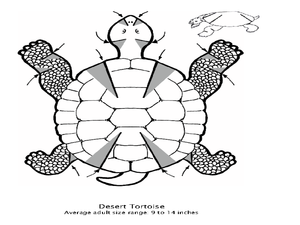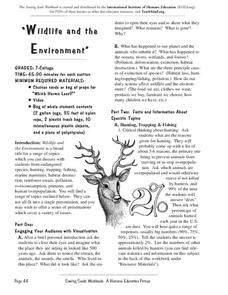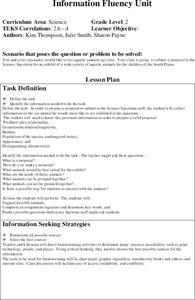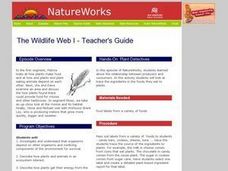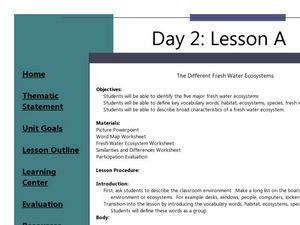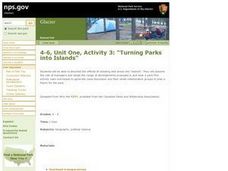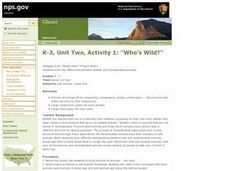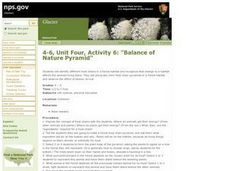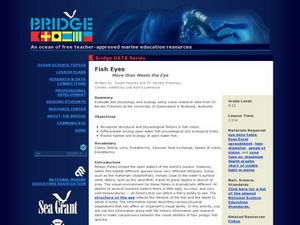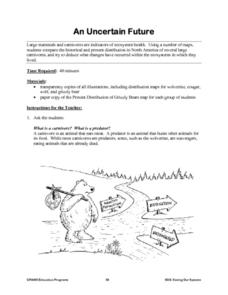Curated OER
Special Place
Learners observe and describe a "special place" chosen along a nature trail. In this habitat observational skills and writing lesson, students take a walk on a nature trail and choose a spot to sit and meditate. Learners complete a...
Curated OER
Butterfly Identification Exercise
Learners examine the various species of butterflies found in Idaho. Using a visual key, they compare and contrast different butterflies with their own sample. In groups, they identify the common and latin name along with its diet and...
Curated OER
Creek Monitoring
Sixth graders conduct a variety of assessments at a local stream to determine if it is a suitable habitat for salmon. They measure temperature, tubidity, dissolved oxygen, pH levels, bacteria and nutrients. In this unit, 6th graders work...
Curated OER
Diamond Terrapin Fun Facts
In this animal worksheet, students complete 6 pages of activities and exercises pertaining to the diamondback terrapin. Students read about the life cycle, study habitat maps and color and cut out a three dimensional turtle.
Curated OER
Animal Characteristics
Students investigate the characteristics of animals by creating a chart. In this animal life lesson, students create a KWL chart listing all the different animals a class can name. Students take a field trip to a science facility to get...
Curated OER
Environmental Education
In this environment learning exercise, students read about the numerous activities and then take part in participating in one as a teacher or student led project.
Curated OER
Toothpick Worms
Students investigate camouflage. In this science lesson plan, students experience the role of color in camouflage as they complete a hands-on activity.
Curated OER
Pond Water
Young scholars explore a creek environment. They make observations, identify the living and nonliving factors in the environment and collect a plankton sample to take back to the classroom. In addition, they look at plankton under a...
Curated OER
What Is a Pond?
Students identify animals and plants that live in a pond. In this marine biology lesson, students create a chart of animals and plants they think they would see at the pond. Students create a "pond symphony" by imitating the sounds they...
Curated OER
Birds of Wisconsin
First graders explore the job done by ornithologists. They role play identifying the characteristics that make a bird a bird. They discuss what makes each bird species unique. Students are introduced to Wisconsin's most common and rare...
Curated OER
Information Fluency Unit
Second graders create a proposal for the Science Spectrum to have an exhibit of a wide variety of aquatic animals for the children of the South Plains. These students would like to see aquatic animals up close.
Curated OER
The Wildlife Web I
Students explore the relationship between producers and consumers. In this activity, they trace the ingredients in the foods they eat to plants. Supplement to Natureworks episode from New Hampshire Public Television, but activities may...
Curated OER
The Different Fresh Water Ecosystems
Students summarize the characteristics of an ecosystem. In this biology lesson, students identify five major fresh water ecosystem. They define terms and write a journal about what they learned.
Curated OER
Turning Parks into Islands
Learners discuss the effects of isolating areas in a park to make "islands" for nature. In this nature instructional activity, students role play park rangers who are developing a new section of the park. Learners work in groups to plan...
Curated OER
My Favorite Animal
Students research an animal of choice and create a project. In this animal science lesson, students choose an animal living in the International Peace Park to research. Students write a paper and create a project to present...
Curated OER
Who's Wild?
Students explore the differences between animals of the wild and domesticated animals. In this wild animals activity, students understand that tame animals ancestors were once wild. Students illustrate the differences by...
Curated OER
Beaver Succession Mural
Students explore the concept of beaver pond succession. In this succession lesson plan, students discuss what succession is and how it works. Students create a mural to present their understanding of this concept.
Curated OER
Balance of Nature Pyramid
Students study the concept of food chains and create a physical forest food chain pyramid. In this balance of nature pyramid lesson, students identify the ingredients needed on each level of the pyramid then make connections...
Curated OER
Which Bear?
Students study bears. In this science lesson, students compare black, grizzly and polar bears. Students measure the bear tracks and compare the bear habitats and diet.
ARKive
Penguin Diversity – Mask Making
Penguins are very diverse and well-adapted birds; they live on islands, in warm and cold climates. Little ones examine penguin diversity and discuss the highly functional adaptive traits that have helped them survive in some of the...
Curated OER
Fish Eyes - More than Meets the Eye
Inform your class about the adaptations in fish eyes: cones, lens size, endothermy, and speed of vision. The adaptations are related to diving behavior. Junior marine scientists compare the adaptations of four different fish species to...
Curated OER
An Uncertain Future
High schoolers study the distribution of large mammals and carnivores in an ecosystem. Using maps and historical data, they examine areas for these animals such as refuges, untouched forests, prairies and grasslands. Students determine...
Curated OER
Reef Sharks!
Students visit an ocean aquarium exhibit where they can observe Black tip reef sharks. They observe the shark's behavior and read any information exhibited on the walls. They complete a worksheet based on information collected.
Curated OER
"We're Back ... Eagles Soar!"
Students use information from Internet websites to create a map of where Bald Eagle habitats can be found after being familiarized with the map by the instructor.



